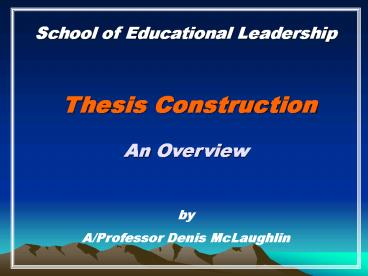Thesis Construction - PowerPoint PPT Presentation
1 / 16
Title:
Thesis Construction
Description:
Right from the beginning of ... logical and cogent argument, which contains and is developed from your own research. and the acknowledged research of others. ... – PowerPoint PPT presentation
Number of Views:337
Avg rating:3.0/5.0
Title: Thesis Construction
1
School of Educational Leadership
Thesis Construction
An Overview
by A/Professor Denis McLaughlin
2
- Right from the beginning of the course,
- it is smart to have your academic efforts
focused on the generation of a thesis. - The thesis is
- a balanced, carefully crafted,
- logical and cogent argument,
- which contains and is developed from your own
research - and the acknowledged research of others.
3
This sophisticated and elaborated argument that
constitutes a thesis must be carefully
structured. The diagram in the next slide
illustrates what is the basic structure for many
doctoral theses. There are variations but this
essential scaffolding is generally clear in most
theses.
4
Traditional Structure of a Thesis Chapter
1 Chapter 2 Chapter 3 Chapter 4 Chapter 5 Chapter
6 Introduction Literature Methods Results Discuss
ion Conclusion Review of results
5
Year One Year Two Year Three (units 1
2) (units 3 4) Literature (Ch
3) Research Problem Questions Design
Data Data Answer area collection analysis ques
tions (unit 1) (unit 1) (unit 1) (unit 3) (Ch
5) (Ch 5) (Ch 6) (Ch 1) (Ch 1) (Ch 1) (Ch
4) Context (unit 1 Ch 2) Pre-empirical
stage Empirical stage
6
Chapter 1 and Chapter 6 balance one another
Chapter 1 sets the scene by
- Briefly and clearly presenting the research
problem, its importance and how the research may
be undertaken. - Explaining its importance.
- Indicating the way the problem will be addressed
through research.
7
- Chapter 6
- summarises the whole research,
- answers the research questions
- provides conclusions to the research problem
- offers recommendations to enhance theory and
improve practice
8
Chapter 2 and Chapter 5 balance one another
Chapter 2 introduces the major voices in the
world of scholarship, who have something to offer
in the conversation concerning your research
problem. You refer to the literature reviewed in
Chapter 2 in writing your Chapter 5, in which
you try to interpret your results within the
broader scholarly conversation.
9
Chapter 3 and Chapter 4 balance one another
Chapter 3 explains and justifies your research
design, which generates specific results, that
are presented (with minimum possible
interpretation) in Chapter 4.
10
Summary
This particular model is the traditional model
based on the scientific (positivist) method.
This approach uses predominantly quantitative
(statistical) research methods. Within the
last 15 years fewer and fewer educational
doctorates have been based in the positivist
paradigm.
11
VARIATIONS SUITED TO QUALITATIVE STUDENTS
Now most education theses use predominantly
qualitative research methods (interviews,
observation etc) and so an adaptation of the
model has evolved.
12
Structure often used in qualitative
theses Chapter 1 Chapter 2 Chapter 3 Chapter
4 Chapter 5 Chapter 6 Research Research Literatur
e Research Presentation Synthesis
Problem Context Review Design
Discussion Conclusions Defined of Results
13
The main differences between Figure 1 and Figure
2 are in Chapters 2 and 5.
Chapter 2
A context chapter is almost always needed
because an explanation of the context thick
description provides peculiar insights and
explanations for your results that the
literature review cannot do.
14
Chapter 5
This chapter combines presentation and discussion
of results. In qualitative research, it is
appropriate to present and then to explain the
data. Separate chapters are particularly
appropriate when statistical data are
predominant. Likewise it is also appropriate when
qualitative data is presented from an
instrument perspective.
15
Sometimes your study might invite an additional
theoretical framework chapter.. This is
because you have justified that your study can
only be understood from a particular theory
perspective. This is essential for a PhD
thesis because its priority is a contribution to
theory.
16
CHAPTER SEQUENCE
- Ch 1 Problem Defined
- Ch 2 Context of the Study
- Ch 3 Theoretical Framework (not usual for EdD)
- Ch 4 Literature Review
- Ch 5 Research Design
- Ch 6 Presentation of results
- Ch 7 Discussion (often in qual studies Ch 6 7
combined) - Ch 8 Conclusions Recommendations































